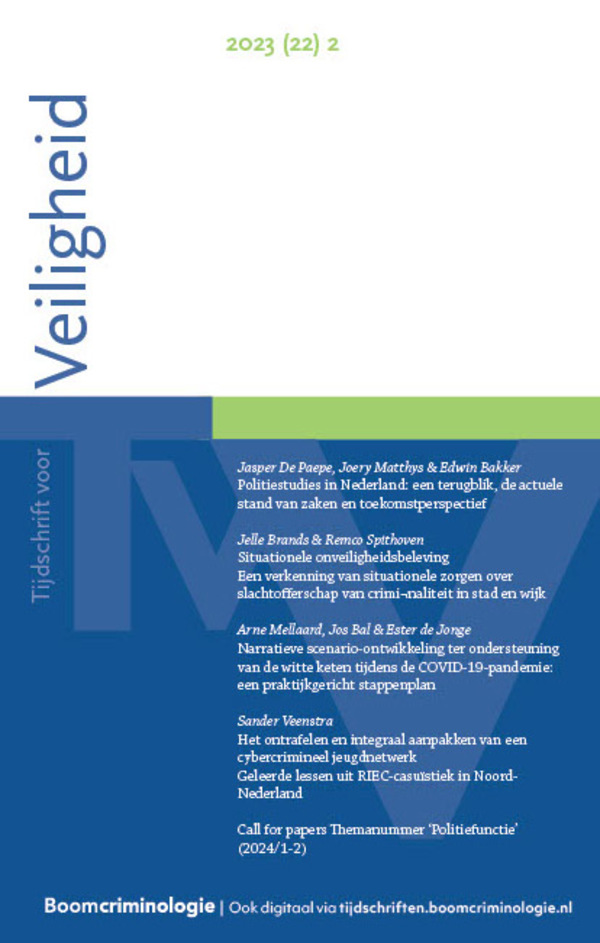|
This special issue reflects about big data applications in policing. Terpstra and Salet (2020) refer to this development as ‘one of the greatest changes within the police about the past decade’ (p. 25). Beside attention to this topic in Dutch literature (e.g. Janssen et al., 2020; Spithoven & Beerends, 2019), the relevance of the subject is also internationally recognized (e.g. Brayne, 2021; Ferguson, 2017; Ridgeway, 2018). In this special issue, we examine – with a view to the past, present and future – how big data could be used in policing in the Netherlands and Belgium. This special issue is not about empirical big data applications, for that we would like to refer to specific studies (e.g., Rummens et al., 2021); in this issue we especially want to outline the breadth of this research area. |


Tijdschrift voor Veiligheid
Meer op het gebied van Criminologie en veiligheid
Over dit tijdschriftMeld u zich hier aan voor de attendering op dit tijdschrift zodat u direct een mail ontvangt als er een nieuw digitaal nummer is verschenen en u de artikelen online kunt lezen.
| Redactioneel |
Big-datatoepassingen bij de politie: een verkenning van een actueel en veelomvattend thema |
| Trefwoorden | big data, politie |
| Auteurs | Thom Snaphaan, Wim Hardyns en Remco Spithoven |
| SamenvattingAuteursinformatie |
| Artikel |
|
| Trefwoorden | predictive policing, big data, police, crime statistics, Belgium |
| Auteurs | Wim Hardyns en Anneleen Rummens |
| SamenvattingAuteursinformatie |
|
Predictive policing is the use of historical crime and other data in complex statistical models to predict where and when there is a high risk of new crime events. These predictions can then be used to direct police patrols proactively. Despite the increasing use and commercialisation of predictive policing worldwide, academic research into the methodological and operational dimensions of predictive policing is relatively limited. Since 2015 we have researched and tested several predictive crime models methodologically and operationally, based on police and other (big) data sources in several Belgian police districts. In this article, we summarise the results of six years of empirical research into predictive policing and look to the future of predictive policing research and practice. |
| Artikel |
Big data, kleine rechtsstaat?Over de roep van uitvoerende professionals om rechtstatelijke bezinning bij big-datatoepassingen in de Nederlandse politiefunctie |
| Trefwoorden | big data, politiefunctie, rechtsstaat, technologische innovatie |
| Auteurs | Remco Spithoven en Elsa Foppen |
| SamenvattingAuteursinformatie |
|
The promises of big data have reached the domain of safety and security. After these techniques proved their added value in the private sector, they soon reached the attention of the public sector. In this article we present the results of our interviews with 27 executive professionals of the Dutch police and the department of public order and safety of local governments. What are their expectations of big data? Their experience with big data varied. Our respondents gave expression to a basic positive attitude towards intelligence led policing and the chances that big data brings to it. But anticipation of working with big data was not free from discussion and the respondents stressed the need for securing privacy and other constitutional rights of citizens before big data applications are implemented in the police function. With that, our respondents strongly aligned with the international, academic call for a constitutional reflection about the application of big data withing the police function. |
| Artikel |
Big data in het veiligheidsdomein: onderzoek naar big-datatoepassingen bij de Nederlandse politie en de positieve effecten hiervan voor de politieorganisatie |
| Trefwoorden | artificial intelligence, big data, police, surveillance, ethics by design |
| Auteurs | Marc Schuilenburg en Melvin Soudijn |
| SamenvattingAuteursinformatie |
|
In recent years, big data technology has revolutionised many domains, including policing. There is a lack of research, however, exploring which applications are used by the police, and the potential benefits of big data analytics for policing. Instead, literature about big data and policing predominantly focuses on predictive policing and its associated risks. The present paper provides new insights into the police’s current use of big data and algorithmic applications. We provide an up-to-date overview of the various applications of big data by the National Police in the Netherlands. We distinguish three areas: uniformed police work, criminal investigation, and intelligence. We then discuss two positive effects of big data and algorithmic applications for the police organization: accelerated learning and the formation of a single police organization. |
| Artikel |
Handvatten voor een kwaliteitsbeoordeling van big data: de introductie van het Total Error raamwerk |
| Trefwoorden | big data, criminology, data quality, total error framework, accuracy |
| Auteurs | Thom Snaphaan en Wim Hardyns |
| Samenvatting |
|
The availability and use of big data sources is increasing exponentially. The variety of new and emerging data sources offers opportunities to complement, replace, improve or add to conventional data sources. Survey data are one kind of conventional data sources. In survey research, a framework to assess the accuracy of survey data already existed for quite some time. This framework is known as the Total Survey Error (TSE) framework. The philosophy behind this framework has only recently been universalized to (big) data in general in the form of the Total Error (TE) framework. This generic framework, which allows for assessing the accuracy of (big) data, is outlined in this article. Additionally, the TE framework is applied to big data sources that could be relevant for policing: police-registered crime data, Twitter data and mobile phone data. |

